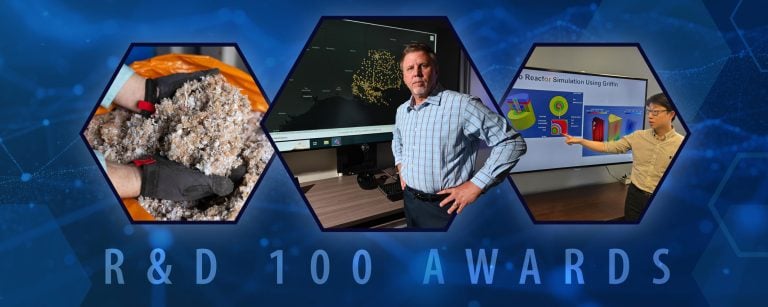With assistance from the Department of Energy’s Gateway for Accelerated Innovation in Nuclear (GAIN) voucher program, Idaho National Laboratory researchers are lending their expertise to two very different companies.
In one corner is Dow, the giant plastics and chemicals manufacturer, that is exploring using microreactors to reduce carbon emissions. In the other corner, Curio Solutions, a Washington, D.C.-based startup that hopes to close the nuclear fuel cycle with a process that avoids proliferation concerns.
Both companies will benefit from the GAIN Initiative, which was launched in 2016 by DOE’s Office of Nuclear Energy (DOE-NE) to speed up the commercialization of new innovations. Under the voucher program, DOE-NE makes the research resources of its national laboratories available, providing funding for 80% of any winning proposal. Private sector participants agree to pick up the remaining 20%, with cost-sharing commitments fulfilled financially or with in-kind services.
Voucher recipients are announced four times a year. Since 2016, 98 vouchers have been awarded totaling $34.7 million. The vouchers funded have received support from seven national laboratories: Idaho, Argonne, Oak Ridge, Pacific Northwest, Sandia, Los Alamos and Savannah River. Some vouchers have supported multi-laboratory collaborations.
Analyzing processes, predicting profitability
The Dow project, announced in the first round of 2023, involves assessing small modular reactors for providing electricity, heat and steam in manufacturing operations. Dow is working to decarbonizing its operations by 2050 and is interested in using SMRs to address the challenge.
“Advanced small modular nuclear technology is going to be a critical tool for Dow’s path to zero-carbon emissions and our ability to drive growth by delivering low-carbon products to our customers,” Jim Fitterling, Dow chairman and chief executive officer, said in a 2023 interview.
Dow will work with INL’s Integrated Energy Systems group, which explores ways to expand the role of nuclear energy beyond supplying electricity to the grid by providing nuclear heat and electricity to various industrial, transportation and energy storage applications.
“Configuring small modular reactors to suit industrial needs will be the challenge,” said Daniel Mikkelson, a computational scientist in the Integrated Energy Systems group.
Since May 2023, Dow and INL have reviewed processes at two of the company’s plants, feeding operational data into the Holistic Energy Resource Optimization Network (HERON) software, a tool within the Framework for Optimization of ResourCes and Economics (FORCE) tool set. Developed by researchers at three national laboratories and four universities, HERON can be used to determine optimal configurations and operating strategies to maximize economics.
The tools will help determine what integration equipment will be needed to meet redundancy targets and how the system will be controlled. Plant operations are dynamic, with factors such as time, heat and electricity consumption all fluctuating during operation. “We’re just setting up the problems using INL’s FORCE tools to get the right answers,” Mikkelson said.
A new way to close the nuclear fuel cycle
The Curio Solutions project was the sole voucher announced in the second round of 2023. The project involves researching new methods for recycling used nuclear fuel using a proprietary electrochemical process called NuCycle. Curio’s technology is different from the existing Plutonium Uranium Reduction Extraction process, which extracts plutonium from used nuclear fuel in a pure stream.
Using molten fluoride salts, NuCycle is designed to avoid producing pure plutonium and dramatically reduces waste volumes associated with existing processes. The advanced processing method produces uranium hexafluoride, which is suitable for re-enrichment to make additional uranium-based fuel, while plutonium can be kept with the remaining actinides and fission products for further processing. Under the voucher, INL researchers will focus on heavier-than-uranium elements known as transuranics, implementing safeguards by design and generating co-extracted actinide products.
INL has a long history of experience with reprocessing used nuclear fuel. The Fuel Conditioning Facility (FCF) at the Materials & Fuels Complex supports multi-program work related to integrated fuel cycle research and development, with a focus on material recovery and waste form development. FCF supports pyro-processing of DOE-owned sodium-bonded metal fuel.
The work for Curio will be different from the molten salt experiments done at FCF, said Robert Hoover, a researcher at the Materials and Fuels Complex. “The fluoride salts take advantage of the uranium fluoride so the uranium fluoride dissolves in the salt. We hope to understand the thermodynamics and examine how they may differ compared to the chloride salts used in FCF.”
Curio CEO Ed McGinnis, a 30-year DOE veteran, said that while he hopes NuCycle helps solve the nation’s nuclear waste challenge by generating smaller quantities of waste for permanent storage, he is even more hopeful about the possibilities for extracting valuable products out of used fuel. These include fuel for advanced reactors and isotopes for space batteries and medical treatments.







